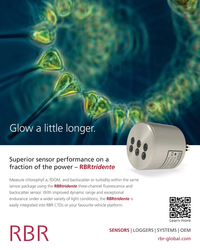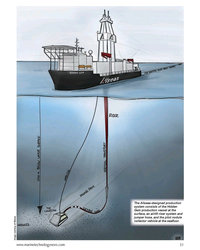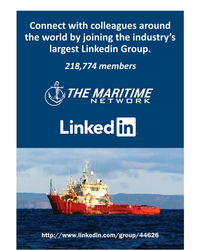Us Department Of Com
-
 )
March 2024 - Marine Technology Reporter page: 4th Cover
)
March 2024 - Marine Technology Reporter page: 4th Coverturbidity with hi i in n n t t th h h he e e s sa a am m m me Measure chlorophyll a, fDOM, and backscatter or turbidity within the same e e sensor package using the RBRtridente three-channel fuorescence and tethree-channel fuorescence and ynamic range and exceptional backscatter sensor. With improved dynamic
-
 )
March 2024 - Marine Technology Reporter page: 48
)
March 2024 - Marine Technology Reporter page: 48. . .Birns, Inc. . . . . . . . . . . . . . . . . . . . . . . . . . . .www.birns.com . . . . . . . . . . . . . . . . . . . . . . . . . . . . . . .Please visit us online 19 . . . . .Blueprint Subsea . . . . . . . . . . . . . . . . . . . .www.blueprintsubsea.com . . . . . . . . . . . . . . . . . . . . . .+44 (0)
-
 )
March 2024 - Marine Technology Reporter page: 47
)
March 2024 - Marine Technology Reporter page: 47??Ý???????S???y???????????????????K???:???? MARINE THE APP TECHNOLOGY FOR NEWS REPORTER Marine TechNews is designed to bring you all the industry news and mar?ne you need, right when you need it. Marine TechNews is available on Googe Play and Itunes. www.marinetechnologynews.com 47 MTR #3
-
 )
March 2024 - Marine Technology Reporter page: 45
)
March 2024 - Marine Technology Reporter page: 45are often denied or restricted. As part of the new alliance, Metron’s Resilient Mission Autonomy portfolio will be integrated into Cellula’s Solus and Imotus families of vehicles to deliver AI-enabled situ- ational awareness and execute real-time onboard mission adaption, rerouting and replanning
-
 )
March 2024 - Marine Technology Reporter page: 44
)
March 2024 - Marine Technology Reporter page: 44. Scandinavia (BUVI) to join its international sales team. Image courtesy Unique Group Sealing the deal(s) @ Oi ‘24 mating the object identi? cation process using the SAS Target in a single work? ow. The sensor’s 360-degree scanner and Assistant. The application runs in the background, leaving us- high collection
-
 )
March 2024 - Marine Technology Reporter page: 43
)
March 2024 - Marine Technology Reporter page: 43Image courtesy Kongsberg Discovery Image courtesy Teledyne Marine New Products Teledyne Marine had its traditional mega-booth at Oi, busy start to ? nish. Image courtesy Greg Trauthwein offers quality sub-bottom pro? ling capability without the need tion of offshore windfarms. GeoPulse 2 introduces new
-
 )
March 2024 - Marine Technology Reporter page: 41
)
March 2024 - Marine Technology Reporter page: 41, a compact remotely operated vehicle (ROV) weighing in at less than 40 lbs (19kg) the ROV- 1500 is easy to transport and deploy. Similar to Outland’s previous models, the ROV-1500 shares an easy to use con- trol system and topside power. Field replaceable components continue to make maintenance a breeze. EvoLogics
-
 )
March 2024 - Marine Technology Reporter page: 39
)
March 2024 - Marine Technology Reporter page: 39Photo courtesy Global Ocean Design Figure 7 A 35Ah AGM lead-acid battery is tested using the West Mountain Radio CBA to show the effect of simply ? lling the battery voids with mineral oil as a compensating ? uid. The CBA is programmed to cut-off at a voltage of 10.50v. The top line (red) shows the
-
 )
March 2024 - Marine Technology Reporter page: 38
)
March 2024 - Marine Technology Reporter page: 38Radio Photo courtesy of Clarios/AutoBatteries.com Figure 6 The West Mountain Radio Computerized Battery Analyzer (CBA V) attaches to a Figure 5 laptop by a USB-B cable, and to a battery by Powerpole® Connectors. Exploded view of an AGM lead-acid battery. ? Nickel-Cadmium (NiCad) batteries have a lower nom-
-
 )
March 2024 - Marine Technology Reporter page: 37
)
March 2024 - Marine Technology Reporter page: 37the top of the riser pipe to vent the gases associated with charging. Wires were soldered to the lead (Pb) posts. The lead-acid battery was additionally used as an expendable ballast weight. Hence, the modi? ed battery as- sembly was contained in a low-cost plywood box potted with hot tar. A pressure-compensat
-
 )
March 2024 - Marine Technology Reporter page: 35
)
March 2024 - Marine Technology Reporter page: 35Figure 1 A self-righting vehicle design with buoyancy high and weight low, WHOI’s SeaBED AUV captures the attention of a pair of curious Antarctic penguins as it is deployed from the British research vessel James Clark Ross. Vehicle designers allowed for temperature reduction of battery capacity. Recharge
-
 )
March 2024 - Marine Technology Reporter page: 33
)
March 2024 - Marine Technology Reporter page: 33regulated industry in the world.” How- ever, commercial success depends on many factors, not least a predictable OPEX. Over the past four years, SMD has worked with Oil States Industries to calculate cost per tonne ? gures for prospective customers. Patania II uses jet water pumps to Oil States’
-
 )
March 2024 - Marine Technology Reporter page: 32
)
March 2024 - Marine Technology Reporter page: 32- the Pentagon is expected to deliver an ac- light plastic tracks and buoyant syntactic foam. The collec- tion plan on nodules by March 2024. tion vehicle uses sonar to identify the position of the nodules UK-based Soil Machine Dynamics (SMD) designed, devel- and has attained collection ef? ciency rates
-
 )
March 2024 - Marine Technology Reporter page: 31
)
March 2024 - Marine Technology Reporter page: 31The Allseas-designed production system consists of the Hidden Gem production vessel at the surface, an airlift riser system and jumper hose, and the pilot nodule collector vehicle at the sea? oor. Image courtesy of Allseas www.marinetechnologynews.com 31 MTR #3 (18-33).indd 31 4/4/2024 2:12:41
-
 )
March 2024 - Marine Technology Reporter page: 29
)
March 2024 - Marine Technology Reporter page: 29a patented nodule collector, Patania II, at 4,500 meters in the Clarion Clipperton Zone in 2021. Full-scale trials will be conducted in 2027. Patania II uses jet water pumps to lift nod- ules into a collection drum. Peer-reviewed research has indicated that released sedi- ment-laden water led to a low-lying
-
 )
March 2024 - Marine Technology Reporter page: 27
)
March 2024 - Marine Technology Reporter page: 27SEA-KIT USV Maxlimer returning from HT-HH caldera in Tonga. © SEA-KIT International data and further assess ecosystem recov- ery. What is known, noted Caplan-Auer- bach, is that the impact of submarine vol- canoes on humans is rare. “The HT-HH eruption was a tragedy, but it was very unusual. It let us
-
 )
March 2024 - Marine Technology Reporter page: 25
)
March 2024 - Marine Technology Reporter page: 25mobilized away still had abundant life, including the Tonga Eruption Seabed Mapping Even before the recent HT-HH erup- corals, sponges, star? sh and mussels. Project (TESMaP) to understand the ex- tion, subsea technology helped scien- This indicated the resilience of certain tent of impact and inform
-
 )
March 2024 - Marine Technology Reporter page: 23
)
March 2024 - Marine Technology Reporter page: 23to the oceanic food chain. DETECTING “Most volcanic activity in the world occurs on the sea? oor, at least if you measure it in terms of the amount of crustal material produced by volcanoes,” added Jackie Caplan-Auerbach, geology professor at THE UNKNOWN Western Washington University. “This is where new
-
 )
March 2024 - Marine Technology Reporter page: 21
)
March 2024 - Marine Technology Reporter page: 21Connect with colleagues around the world by joining the industry’s largest Linkedin Group. 218,774 members http://www.linkedin.com/group/44626 MTR #3 (18-33).indd 21 4/4/2024 3:37:21 PM
-
 )
March 2024 - Marine Technology Reporter page: 19
)
March 2024 - Marine Technology Reporter page: 19is a Cathodic Protection and corrosion control cant cost savings, mainly related to vessel charter. expert having worked across The major advantage of using FiGS on any type of subsea engineering, design, modelling, structure is the large amount of accurate information obtained project management, inspection
-
 )
March 2024 - Marine Technology Reporter page: 17
)
March 2024 - Marine Technology Reporter page: 17or cell to cell technologies which also required There are several methods available for measuring CP condi- frequent calibration stabs are limited to just providing a poten- tion, and a combination of these methods may also be used to tial pro? le on the structure/pipeline based on known formulas. obtain
-
 )
March 2024 - Marine Technology Reporter page: 15
)
March 2024 - Marine Technology Reporter page: 15sensor options for longer mission periods. About the Author For glider users working in ? sheries and conservation, Shea Quinn is the Product Line Manager the Sentinel can run several high-energy passive and active of the Slocum Glider at Teledyne Webb acoustic sensors, on-board processing, and imaging
-
 )
March 2024 - Marine Technology Reporter page: 13
)
March 2024 - Marine Technology Reporter page: 13nyone familiar with glider hardware options integrated for a broad Glider answers that need,” said Shea autonomous underwater ve- range of missions. Quinn, Slocum Glider Product Line hicles (AUVs) is certainly “As the use of Slocum Gliders grew, Manager at TWR. A familiar with the popular- so did
-
 )
March 2024 - Marine Technology Reporter page: 11
)
March 2024 - Marine Technology Reporter page: 11and founder of lenges. Unlike contact mines, bottom Strikepod Systems, a research and strategic advisory mines utilize a range of sensors to de- focusing on autonomous undersea systems. tect their prey – acoustic, magnetic, pressure – and as such pose a hazard to manned MCM vessels. To safely detect
